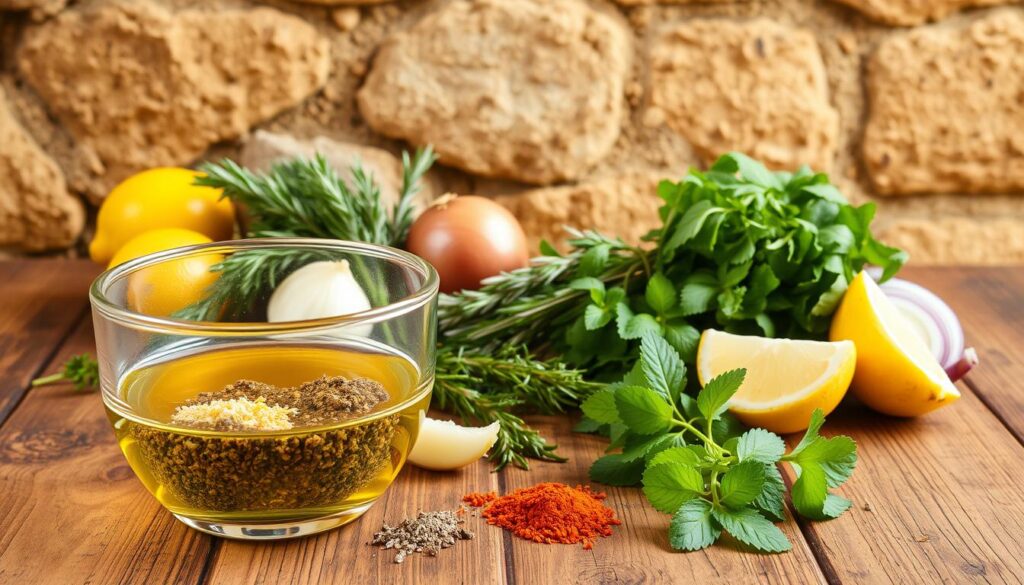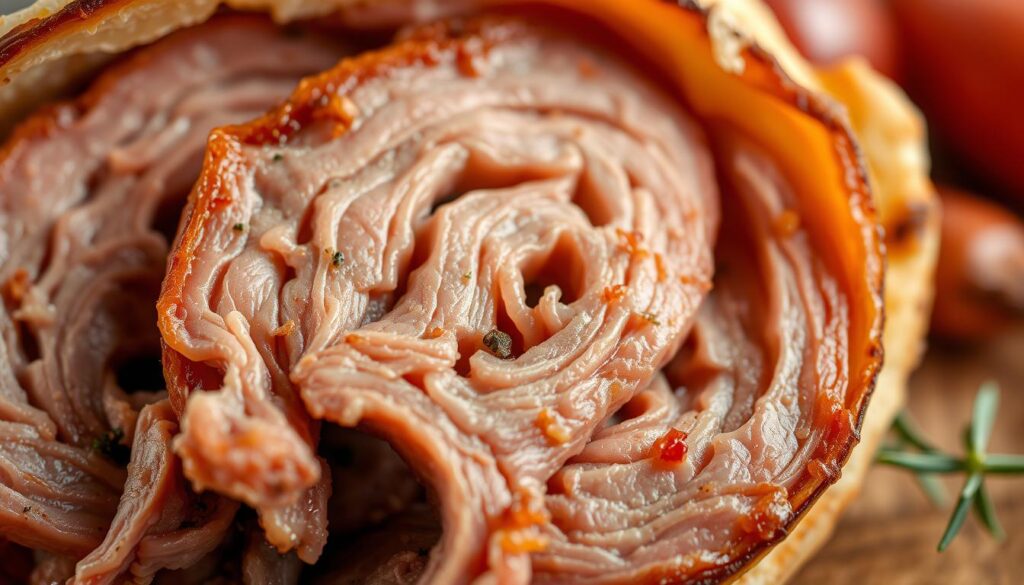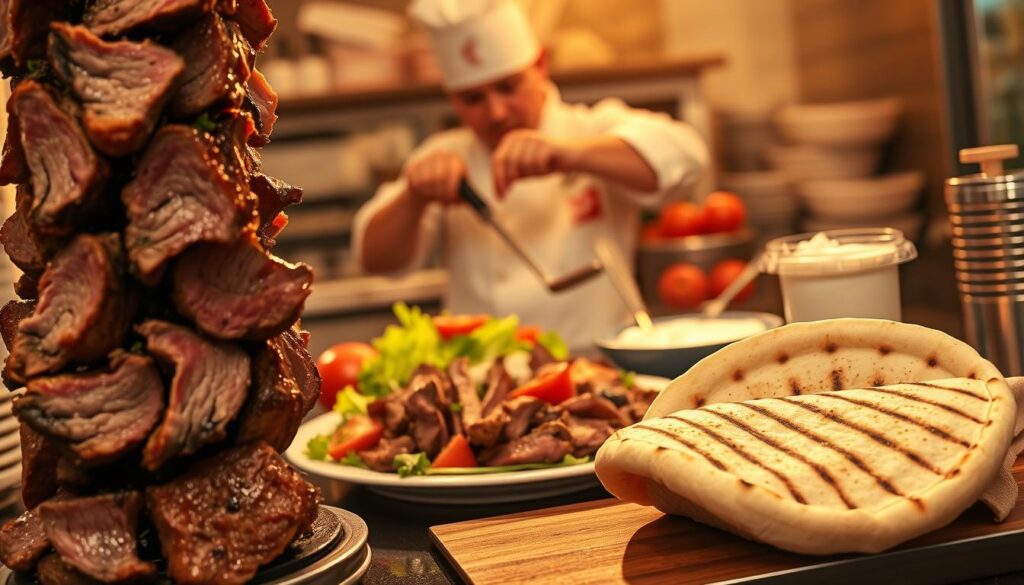What if you could recreate that perfect blend of crispy and tender meat, wrapped in warm pita and drizzled with creamy sauce—all without leaving your kitchen? The secret lies in mastering a dish that balances tradition with modern simplicity.
This iconic street food has evolved over generations, blending authentic techniques with regional twists. While some versions use thinly sliced pork, others rely on seasoned meat blends cooked on a vertical rotisserie. The result? A mouthwatering contrast of textures that keeps people coming back for more.
You don’t need professional equipment to achieve that signature flavor. With the right marinade and cooking method, even home chefs can craft layers of savory goodness. We’ll guide you through selecting quality ingredients, balancing spices, and assembling the perfect bite.
Key Takeaways
- Learn the difference between traditional and modern preparation styles
- Discover how to achieve crispy edges while keeping meat juicy
- Master essential marinades for maximum flavor depth
- Explore tips for assembling authentic-tasting wraps at home
- Understand the cultural roots of this globally loved dish
Introduction to Greek Lamb Gyros
The aroma of sizzling meat on a rotating spit has captivated food lovers for centuries. This cooking method creates a golden crust while locking in natural juices—a technique perfected in coastal towns where fresh ingredients meet time-honored traditions.
From Ancient Fires to Modern Flavors
Rotating-spit cooking dates back to Ottoman-era kitchens, where chefs layered seasoned cuts into towering cones. The word “gyros” reflects this circular motion, derived from the Greek term for “turn.” Originally prepared with pork, regional variations now feature other proteins marinated in olive oil, vinegar, and aromatic spices.
“The magic happens when heat meets motion—every rotation builds flavor you can’t replicate in a pan.”
Why This Dish Dominates Street Food Culture
Three elements make this handheld meal irresistible:
| Factor | Traditional Approach | Modern Twist |
|---|---|---|
| Cooking Method | Vertical rotisserie | Home oven alternatives |
| Texture | Crispy exterior | Smoky grill marks |
| Serving Style | Pita wrap with tzatziki | Lettuce wraps for low-carb |
Street vendors perfected the art of balancing convenience with bold tastes. Each bite delivers contrasting textures—crunchy vegetables against tender meat shavings—wrapped in warm flatbread. This portable feast embodies Mediterranean hospitality, turning quick meals into shared experiences.https://cohesiverecipes.com/making-lamb-chops/
Essential Ingredients & Marinade Secrets

The foundation of any memorable meal lies in its components. Quality ingredients and thoughtful preparation turn simple dishes into culinary treasures. Let’s explore what makes the difference between good and extraordinary results.
Choosing the Right Cut
Shoulder meat reigns supreme for its perfect balance of flavor and texture. This cut’s generous marbling – those creamy streaks of fat – melts during cooking, basting the meat from within. Look for vibrant pink flesh with even fat distribution when selecting your protein.
While leg offers leaner options, shoulder’s connective tissue transforms under heat. It creates that signature tenderness while locking in moisture. Always trim excess fat caps, leaving just enough to enhance juiciness without overwhelming the palate.
The Science of Seasoning
Salt works magic beyond flavor enhancement. When massaged into meat, it unravels proteins to form a moisture-trapping web. This process requires at least one hour, though overnight marination yields superior texture. A chef once noted: “Time is your silent sous-chef here – let it work.”
Combine these essentials for maximum impact:
- Oregano (preferably Greek rigani) for earthy depth
- Fresh garlic to cut through richness
- Sweet paprika’s subtle warmth
- Olive oil as flavor conductor
The right blend creates harmony between crispy caramelized edges and succulent interiors. Remember: fat content dictates cooking time – richer cuts need slower heat to render properly without drying out.
Mastering the Perfect greek lamb gyros at Home

Creating that signature gyros texture at home hinges on one surprising technique: approaching the meat like a seasoned sausage maker. While professional kitchens use vertical spits, home cooks can achieve similar results by mastering three core principles – fat distribution, temperature control, and mechanical binding.
Traditional Techniques Versus Modern Kitchen Hacks
Forget trying to mimic a commercial rotisserie – your food processor becomes the MVP here. Blend chilled ground meat with spices until it forms a smooth paste. This emulsification creates the springy texture that holds together during cooking, just like traditional sausage-making methods.
Three game-changing modern hacks:
- Freeze your mixing bowl before processing to keep fats firm
- Use parchment paper to shape the mixture into compact logs
- Broil on high heat for 2 minutes to create crispy edges
“The magic isn’t in the equipment – it’s in understanding how proteins behave under different conditions,” notes a chef specializing in Mediterranean recipes. By treating your meat mixture like dough (chill, knead, rest), you develop the perfect bite without specialized tools.
For rotisserie-style results, bake your seasoned log at 325°F first. Finish under the broiler to mimic the caramelized crust from open-flame cooking. This dual-method approach solves both texture and equipment challenges in one clever recipe.
Step-by-Step Recipe Process

Discover how a few key techniques can elevate your homemade meals to restaurant quality. This method balances science and simplicity, transforming basic ingredients into layered perfection through precise timing and temperature control.
Prepping and Marinating the Lamb
Start by combining ground meat with salt, pepper, and oregano in a chilled bowl. Mix vigorously until the seasoning coats every grain evenly – this creates flavor channels that penetrate deep into the protein. “The friction from hand-mixing activates the meat’s natural binders,” explains a culinary instructor.
Refrigerate the mixture for at least one hour. This resting time lets the salt restructure proteins, forming a moisture-trapping matrix. For best results, let it sit overnight. The transformed texture will feel springy yet pliable when ready for shaping.
Baking and Broiling for Crispy, Juicy Edges
Process the chilled meat with onion, garlic, and bacon until smooth. Form into 8-inch rectangular logs using wet hands to prevent sticking. Bake at 300°F for 30 minutes – low heat gently cooks the center without drying edges.
Slice the loaf into thin strips and broil for 2 minutes. This final blast creates caramelized crunch while keeping interiors succulent. Serve immediately in warm pita with crisp veggies and tangy sauce for that authentic street-food experience.
Cooking Techniques and Equipment Alternatives
Professional kitchens rely on specialized tools, but your home setup holds untapped potential. Understanding vertical rotisserie mechanics reveals why thin slicing transforms ordinary meals into crave-worthy creations.
Maximizing Crispness Without Fancy Gear
Slice pre-cooked meat into 1/8-inch strips before broiling. This exposes more surface area to heat, mimicking how chefs shave caramelized layers from rotating spits. The result? Every bite balances crackling edges with juicy centers.
Try this game-changing method:
- Chill cooked lamb loaf for easy slicing
- Arrange pieces in a single layer on a baking sheet
- Broil 2-3 minutes until edges bubble and darken
Your broiler becomes a flavor amplifier. Toaster ovens work equally well for small batches, letting you control browning precisely. Prep multiple portions ahead – refrigerate sliced meat for quick weeknight meals that taste freshly charred.
This approach outsmarts traditional vertical rotisserie limitations. You decide exactly how crispy each serving gets while keeping interiors tender. No special equipment needed – just smart cooking techniques that honor the dish’s textural magic.
Pingback: Rogan Josh: Explore the Aromatic Flavors of This Indian Classic